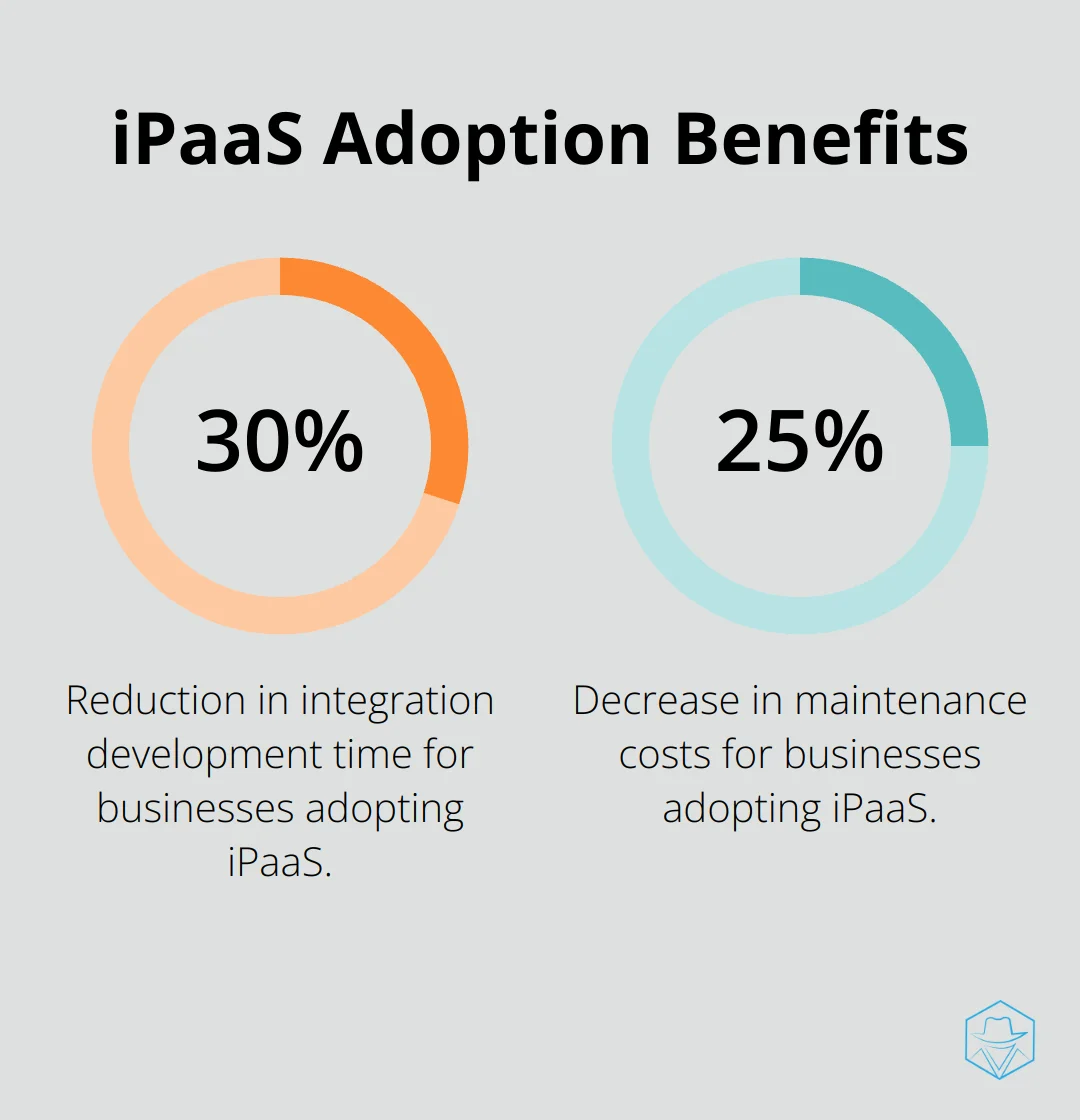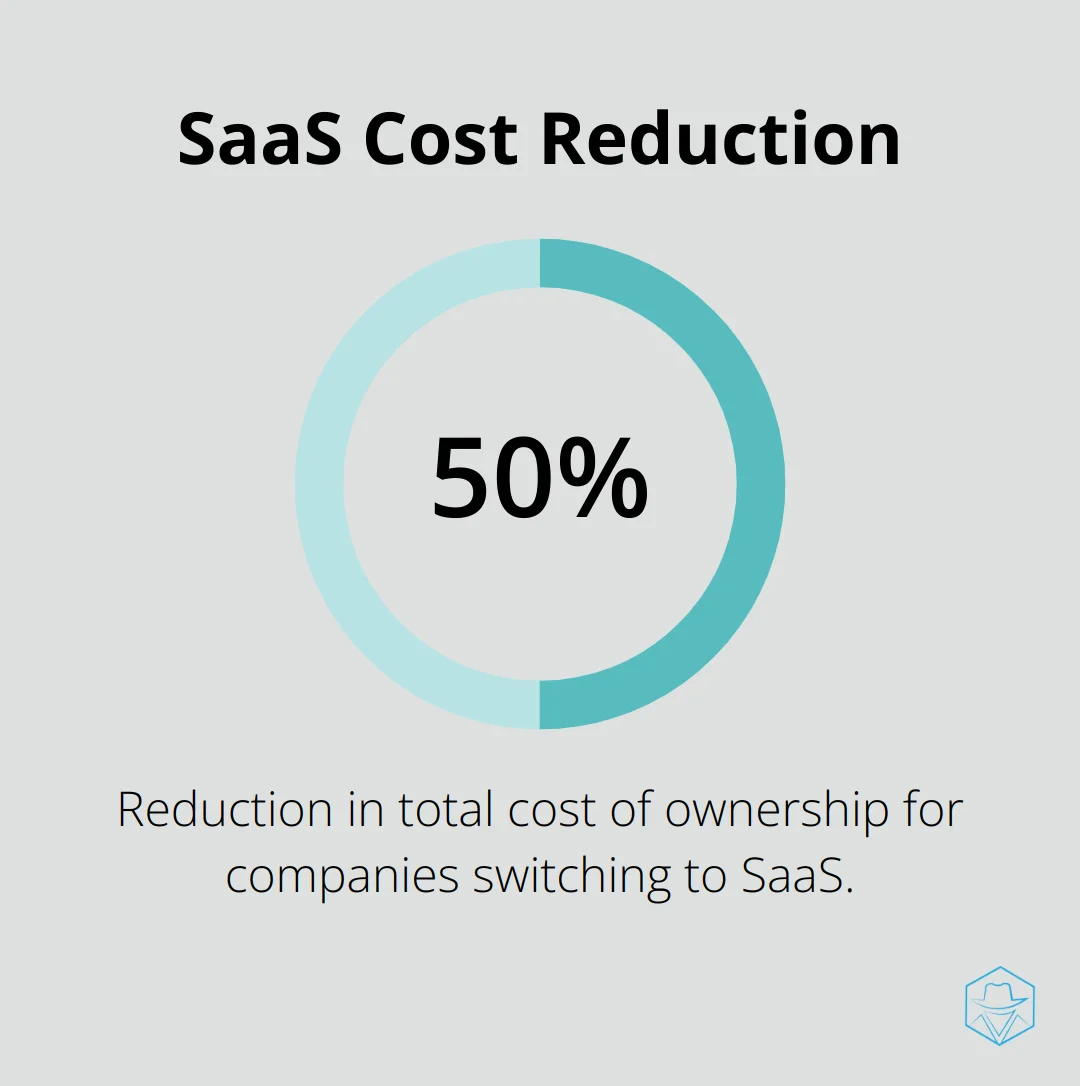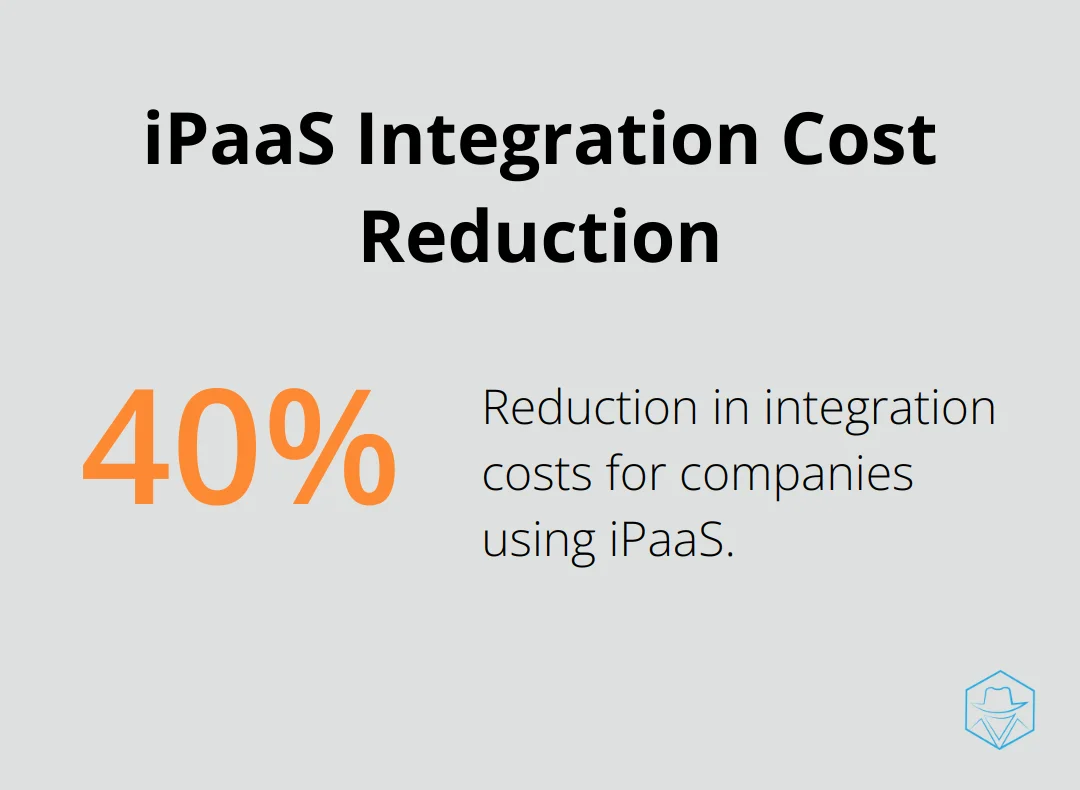iPaaS vs SaaS: Which Is Right for Your Business?

At Drop Cowboy, we often field questions about cloud-based solutions for businesses. Two terms that frequently come up are iPaaS and SaaS.
In this post, we’ll explore the iPaaS vs SaaS debate, breaking down their definitions, use cases, and key differences.
By the end, you’ll have a clear understanding of which option might be the best fit for your company’s needs.
What Is iPaaS and How Does It Work?
Definition and Core Function of iPaaS
iPaaS (Integration Platform as a Service) is a cloud-based solution that connects various applications and systems within a business. It acts as a digital bridge, allowing different software to communicate and share data seamlessly.
The Mechanics of iPaaS
iPaaS provides a centralized platform where businesses can create, manage, and monitor integrations between different applications. This eliminates the need for complex, custom-coded integrations that often prove time-consuming and expensive to maintain. Instead, iPaaS offers pre-built connectors and visual tools that simplify the integration process.
A company might use iPaaS to connect their customer relationship management (CRM) system with their e-commerce platform. This integration could automatically update customer information in the CRM when a purchase occurs on the e-commerce site, ensuring that sales teams have the most up-to-date data.
Real-World Applications of iPaaS
Many businesses use iPaaS to streamline their operations and improve efficiency. For example:
- A manufacturing company might leverage iPaaS to connect their inventory management system with their supply chain software, automatically triggering reorders when stock levels drop below a certain threshold.
- In the healthcare sector, iPaaS can integrate electronic health records (EHR) systems with billing software, ensuring accurate and timely patient invoicing. This not only reduces administrative workload but also minimizes errors that can occur with manual data entry.
The Advantages of Implementing iPaaS
Implementing iPaaS can lead to significant time and cost savings. A study by Forrester reported that businesses that adopted iPaaS solutions saw a 30% reduction in integration development time and a 25% decrease in maintenance costs.
Moreover, iPaaS enhances data accuracy and consistency across an organization. The automation of data transfers between systems reduces the risk of human error and ensures that all departments work with the same, up-to-date information.

iPaaS in Action: A Closer Look
To illustrate the power of iPaaS, consider a mid-sized e-commerce company (let’s call it “TechGear”) that sells electronics online. TechGear uses separate systems for inventory management, order processing, and customer support. Before implementing iPaaS, their staff had to manually update each system, leading to delays and errors.
After adopting an iPaaS solution, TechGear integrated all these systems. Now, when a customer places an order, the inventory system automatically updates, the order processing system initiates fulfillment, and the customer support system is notified with all relevant details. This seamless integration has significantly improved TechGear’s operational efficiency and customer satisfaction.
As we move forward, it’s important to understand another key player in the cloud-based business solutions arena: Software as a Service (SaaS). Let’s explore how SaaS differs from iPaaS and what unique benefits it brings to the table.
What Is SaaS and How Can It Benefit Your Business?
Defining SaaS: A Cloud-Based Revolution
Software as a Service (SaaS) has transformed business operations in the digital age. SaaS is a cloud-based software delivery model where third-party providers host and maintain applications, which users access via the internet.
The SaaS Advantage: Cost-Effectiveness and Scalability
SaaS offers significant benefits for businesses of all sizes. Cost-effectiveness stands out as a primary advantage. A Forrester Research study revealed that companies switching to SaaS can reduce their total cost of ownership by up to 50% compared to traditional on-premise software. This reduction stems from lower hardware costs, decreased IT staffing requirements, and the elimination of expensive software upgrades.

Scalability is another key benefit of SaaS. Companies can easily add more users or features as they grow, without the need for additional infrastructure. This flexibility allows businesses to adapt quickly to changing market conditions and evolving needs.
Popular SaaS Applications: Transforming Business Functions
The SaaS market offers solutions for almost every business function. Customer Relationship Management (CRM) tools like Salesforce have become essential for many companies. Salesforce reports that their customers experience an average 37% increase in sales revenue after implementing their CRM.
Project management tools (such as Asana and Trello) have revolutionized team collaboration. An Asana survey found that teams using their platform report a 45% reduction in emails and a 30% decrease in meetings.
For financial management, applications like QuickBooks Online have made accounting more accessible for small businesses. Intuit, the company behind QuickBooks, states that users of their online platform save an average of 11 hours per month on bookkeeping tasks.
SaaS in Action: A Real-World Example
To illustrate the power of SaaS, consider a mid-sized marketing agency that struggled with project management and client communication. They implemented a combination of SaaS tools: Asana for project management, Slack for team communication, and HubSpot for client relationship management.
The results were impressive. The agency reported a 25% increase in productivity within the first three months. They took on more clients without increasing staff, leading to a 15% boost in revenue. Moreover, client satisfaction scores improved by 30% due to better communication and project delivery.
Selecting the Right SaaS Solution
When choosing a SaaS application for your business, it’s important to consider factors like functionality, scalability, integration capabilities, and security. We recommend thoroughly evaluating your business needs and comparing multiple options before making a decision.
It’s worth noting that while many SaaS providers offer excellent solutions, they may not always meet all your specific requirements. This is where specialized platforms can complement your existing SaaS stack. For instance, if you need advanced communication features (like ringless voicemail or SMS marketing capabilities), Drop Cowboy offers these specialized services to enhance your SaaS ecosystem.
As we explore the world of cloud-based business solutions, it’s important to understand how SaaS compares to other options like iPaaS. In the next section, we’ll examine the key differences between these two approaches and help you determine which might be the best fit for your business needs.
iPaaS or SaaS: Which Fits Your Business?
Core Functions and Use Cases
iPaaS primarily connects various applications and systems within your business ecosystem. It acts as the glue that holds your tech stack together, enabling seamless data flow and process automation across different platforms. SaaS delivers specific software functionalities over the internet, providing ready-to-use applications for various business needs.
A Gartner study found that companies using iPaaS reduced their integration costs by up to 40% compared to traditional methods. This significant cost reduction stems from the elimination of custom coding and the streamlined maintenance of integrations.

SaaS offers its own set of financial benefits. According to a Forrester report, businesses adopting SaaS solutions saw an average ROI of 150% over three years, primarily due to reduced infrastructure costs and increased productivity.
Scalability and Flexibility
iPaaS excels in scalability for complex environments. As your business grows and adopts new technologies, iPaaS allows you to add or modify integrations easily without overhauling your entire system. This flexibility proves crucial for businesses in rapidly evolving industries or those undergoing digital transformation.
SaaS applications, while scalable in terms of user numbers and features, have more limitations in their ability to adapt to unique business processes. They offer a standardized set of functions that may not always align perfectly with specific company needs.
Implementation and Expertise Required
Implementing an iPaaS solution typically requires a higher level of technical expertise. While modern iPaaS platforms offer user-friendly interfaces, effectively leveraging their full potential often necessitates a deep understanding of data structures and integration patterns.
SaaS applications are designed for ease of use and quick implementation. A study by BMC Software revealed that SaaS deployments are, on average, 50% faster than traditional software installations. This rapid deployment can change the game for businesses looking to quickly adopt new functionalities.
Making the Right Choice for Your Business
The choice between iPaaS and SaaS depends on your specific business needs. If your primary challenge involves connecting multiple systems and automating complex workflows, iPaaS likely serves as the better choice. A survey by MuleSoft found that businesses using iPaaS reported a 35% increase in operational efficiency due to improved data synchronization and process automation.
However, if you seek specific software functionalities without the need for extensive customization or integration, SaaS might prove more suitable. The 2023 State of SaaS report indicates that 73% of organizations believe SaaS helps them accelerate their time to market for new products and services.
These solutions aren’t mutually exclusive. Many businesses find value in combining both iPaaS and SaaS to create a comprehensive, efficient tech ecosystem. For instance, you might use SaaS applications for your core business functions while employing iPaaS to ensure these applications work seamlessly together.
Final Thoughts
iPaaS and SaaS offer distinct advantages for businesses aiming to enhance operations and efficiency. iPaaS excels at connecting diverse systems, enabling smooth data flow and process automation across your technology ecosystem. SaaS provides specific, ready-to-use applications that address particular business needs with quick deployment and scalability.
The choice between iPaaS vs SaaS depends on your company’s primary challenges and goals. If you struggle with integrating multiple systems and automating complex workflows, iPaaS might be the optimal solution. For those seeking specific software functionalities without extensive customization, SaaS could better suit your needs.
At Drop Cowboy, we offer communication solutions that complement your existing tech stack, regardless of whether you use iPaaS, SaaS, or a combination. Our platform can enhance your marketing efforts through features like ringless voicemail and SMS integration. The evolving landscape of cloud-based services and integration will likely see continued growth, with increased focus on AI-driven integrations and enhanced security measures.
blog-dropcowboy-com
Related posts

June 27, 2025
Power Dialer: Accelerate Your Sales Calls
Explore what is Power Dialer and boost your sales efficiency with faster calls and increased productivity through Drop Cowboy’s smart calling solutions.

June 16, 2025
How Much Does EZ Texting Cost? Pricing Explained
Explore EZ Texting pricing, understand costs, and find a plan that fits your texting needs. Get the details you need for smart decision-making.

June 2, 2025
Top-Rated Real Estate CRM: Boost Your Agency’s Efficiency
Boost your agency’s efficiency with a top-rated real estate CRM. Discover essential features and advantages for streamlined operations today.

July 20, 2025
How Does Telesign Compare to Twilio?
Compare Telesign vs Twilio to understand their features, pricing, and reliability. Make an informed decision with our comprehensive analysis.

July 20, 2025
Telesign SMS Pricing: What You Need to Know
Learn about Telesign SMS pricing to make informed decisions for your business with our comprehensive breakdown of costs, benefits, and alternatives.

July 20, 2025
Comparing Leading CCaaS Platforms: Features and Benefits
Compare CCaaS platforms to find the best features and benefits for your business needs. Make informed decisions with our detailed analysis.